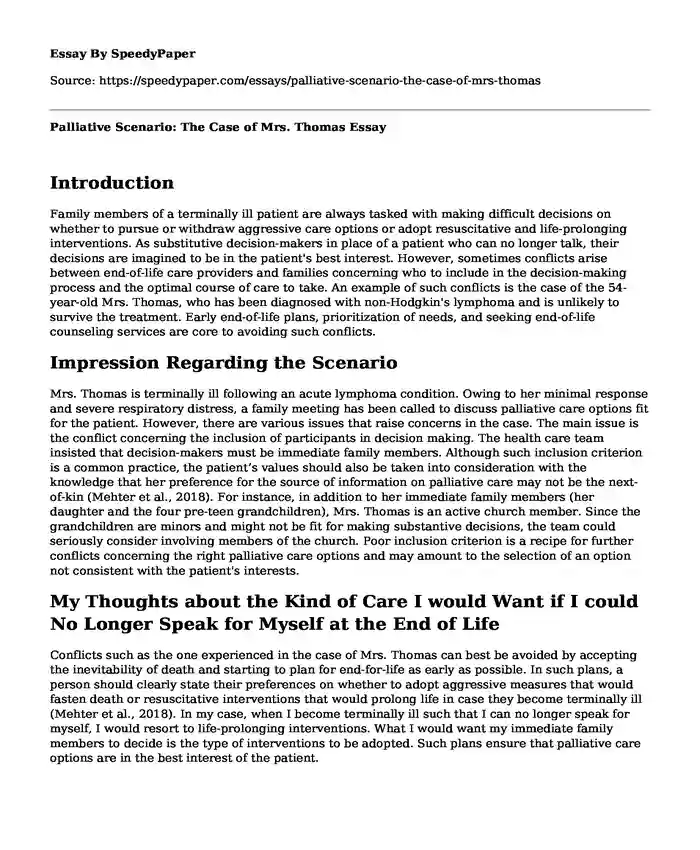
| Type of paper: | Essay |
| Categories: | Healthcare Conflict resolution Conflict management |
| Pages: | 3 |
| Wordcount: | 779 words |
Introduction
Family members of a terminally ill patient are always tasked with making difficult decisions on whether to pursue or withdraw aggressive care options or adopt resuscitative and life-prolonging interventions. As substitutive decision-makers in place of a patient who can no longer talk, their decisions are imagined to be in the patient's best interest. However, sometimes conflicts arise between end-of-life care providers and families concerning who to include in the decision-making process and the optimal course of care to take. An example of such conflicts is the case of the 54-year-old Mrs. Thomas, who has been diagnosed with non-Hodgkin's lymphoma and is unlikely to survive the treatment. Early end-of-life plans, prioritization of needs, and seeking end-of-life counseling services are core to avoiding such conflicts.
Impression Regarding the Scenario
Mrs. Thomas is terminally ill following an acute lymphoma condition. Owing to her minimal response and severe respiratory distress, a family meeting has been called to discuss palliative care options fit for the patient. However, there are various issues that raise concerns in the case. The main issue is the conflict concerning the inclusion of participants in decision making. The health care team insisted that decision-makers must be immediate family members. Although such inclusion criterion is a common practice, the patient’s values should also be taken into consideration with the knowledge that her preference for the source of information on palliative care may not be the next-of-kin (Mehter et al., 2018). For instance, in addition to her immediate family members (her daughter and the four pre-teen grandchildren), Mrs. Thomas is an active church member. Since the grandchildren are minors and might not be fit for making substantive decisions, the team could seriously consider involving members of the church. Poor inclusion criterion is a recipe for further conflicts concerning the right palliative care options and may amount to the selection of an option not consistent with the patient's interests.
My Thoughts about the Kind of Care I would Want if I could No Longer Speak for Myself at the End of Life
Conflicts such as the one experienced in the case of Mrs. Thomas can best be avoided by accepting the inevitability of death and starting to plan for end-for-life as early as possible. In such plans, a person should clearly state their preferences on whether to adopt aggressive measures that would fasten death or resuscitative interventions that would prolong life in case they become terminally ill (Mehter et al., 2018). In my case, when I become terminally ill such that I can no longer speak for myself, I would resort to life-prolonging interventions. What I would want my immediate family members to decide is the type of interventions to be adopted. Such plans ensure that palliative care options are in the best interest of the patient.
How to Handle the Family Members and Friends Wanting to Be Included in the Discussion
It is difficult to decide on who to include in end-of-life discussions when the patient is no longer in a position to speak for herself. It is also impractical to include every person that wishes to be included. It is important to emphasize that for a person to be included in such discussions, he or she must be an adult immediate family member or a very acquaintance that the patient was very close to (Lichtenthal & Kissane, 2008). Family members to be included are spouses, children, and parents. Others, including cousins, niece, and nephews, should only be included either in the absence of the three immediate family members or if it is in the best interest of the patient. Another way to avoid such confusion is by invoking such discussions when the patient is still strong enough to express his or her desires.
Conclusion
Making palliative care decisions, especially when patients can no longer speak for themselves, can be challenging. The professional caregivers are, therefore, tasked with identifying the immediate family members and close friends to take part in palliative care discussions. However, inclusion conflicts are expected, especially when a person has an extended family and strong social ties, as in the case of Mrs. Thomas. Early end-of-life planning is critical in avoiding such conflicts.
References
Lichtenthal, W. G., & Kissane, D. W. (2008). The management of family conflict in palliative care. Progress in Palliative Care, 16(1), 39-45. https://doi.org/10.1179/096992608x296914
Mehter, H. M., McCannon, J. B., Clark, J. A., & Wiener, R. S. (2018). Physician approaches to conflict with families surrounding end-of-life decision-making in the intensive care unit. A qualitative study. Annals of the American Thoracic Society, 15(2), 241-249. https://doi.org/10.1513/annalsats.201702-105oc
Cite this page
Palliative Scenario: The Case of Mrs. Thomas. (2023, Dec 24). Retrieved from https://speedypaper.net/essays/palliative-scenario-the-case-of-mrs-thomas
Request Removal
If you are the original author of this essay and no longer wish to have it published on the SpeedyPaper website, please click below to request its removal:
- Free Essay on Over the Counter Pharmacology Mood Disorder Supplements at Walgreens
- Free Essay on the Schizophrenia Case: Diagnosis and Treatment
- Essay Example for Free: VHA Innovative Model Analysis
- Essay Sample Describing the Effect of Vegetarian Diet on Weight Reduction
- Free Essay - Corporate Social Responsibility
- Essay Sample on The Relationship Between Industrialization and the Spread of Disease
- Navigating Genetic Factors and Cognitive Development Through the Lens of Piaget's Theory - Essay Sample
Popular categories




